5.18 SP1 Maytas ESFA Release Notes
Note regarding submissions
We would like to remind providers to create a submission early and check for any errors using reports from the appropriate software (i.e. the FIS or LLWR-Inform). Welsh providers should also remember to download their ULI file. After submission to the ESFA or DfES, providers should check that data has submitted correctly using the available reports. Providers should check that all their expected starts and completions are submitted correctly, and that start and outcome payments correctly match the PFR or ACE funding reports.
Our support desk gets extremely busy in the days prior to the submission deadlines, and although we try and prioritise submission-related queries, we cannot guarantee assistance if queries are sent late. If you do encounter any issues, please ensure that you contact Maytas Support as soon as possible, as we can only rectify issues of which we are aware. We also recommend checking Maytas Communities regularly for information on any known issues and solutions. Tribal cannot be held responsible for any issues caused by your failure to comply with this advice.
Technical specification
The latest Maytas and e-track technical specification can be found here.
Once the upgrade has been completed, the version number should be checked to ensure it has been successful.
- Start Maytas and go to Support on the toolbar.
- Click About.
- The version numbers should read 181.20 / 5.18.7201.2. If you have any other version, please ensure you have followed the upgrade instructions correctly. If you require assistance, please contact Maytas Support.
It is the responsibility of customers to ensure that users carry out any required user acceptance testing and sign off on the upgrade.
Complete the Upgrade
Features Added in the Upgrade
These are the main updates in the upgrade:
- PFR Reconcilers for 2019/20
- Financial Planning 2019/20 rollover
- AS export updates
- Copy tabs PCR for 5.18
- Data collection queue
- Fixes to a number of issues
Reports Library 1.0.3.3 is also included in the upgrade but must be installed separately, which is detailed in the Upgrade Guide. The reports library can be downloaded here. If you are a hosted customer, please contact the Service Desk to arrange for the reports library update to be applied.
Import Funding Information
Due to the major changes to the FIS for 2019/20, the process for importing the required funding information into Maytas is now as follows:
- The old FIS 2018/19 application should be used to import data sets for 2018/19 and earlier, as per previous releases. This only needs to be performed once more after the upgrade and then it will no longer be required in future releases.
- The LARS for 2019/20 should be imported.
- Postcode data for 2019/20 should be imported.
- Once all data has been imported, ensure that the funding cache is refreshed (either on a database schedule or a manual update out of working hours).
Re-Import the FIS Data Sets
It is essential that the FIS data sets for 2018/19 and earlier are imported into Maytas one final time for use by the funding cache. This should be done by importing the relevant information directly from the Data Service’s Funding Information System (FIS). To do this, you must have the FIS installed and correctly configured (please refer to the Data Service’s instructions for setting up the FIS).
Please ensure you have the latest version of the 2018/19 FIS application with the latest components installed.
Once the FIS is installed and configured, the information can be imported as follows:
- Perform a sync in Maytas 5, then restart Maytas 5.
-
Go to Exports | Uploads | Upload FIS Data Sets.
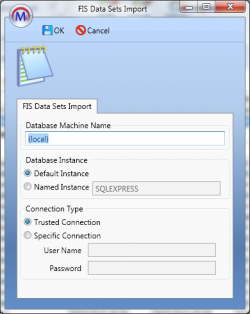
- There are three items to configure:
- Database Machine Name – If the FIS is installed on the same machine that you are using for Maytas 5, this can be left as (local). Otherwise, enter the machine name of the SQL server where the FIS database is held.
Database Instance – If the SQL server holding the FIS database has a named instance (e.g. MACHINENAME\INSTANCENAME), select Named Instance and enter the instance name. Otherwise leave this as Default Instance.
If you have no named instance and Default Instance does not work, you may need to select Named Instance and leave the instance name blank.
- Connection Type – This is the login for the SQL server holding the FIS database. Trusted Connection will use Windows authentication. If you wish to specify the login details, select Specific Connection and enter the credentials.
- Click OK. The FIS data will now be imported.
- If you have an Adult Skills budget contract and a transition factor, this must be entered on the contract:
- Go to Management on the toolbar and click Contracts on the ribbon.
- Select the relevant contractor, then select the Adult Skills contract on the right.
- Click the
 button.
button. - Go to the Uplifts tab.
- Enter the ASB Transition Factor and click OK.
- Click Apply to save the change.
Import LARS
The LARS for 2019/20 should be imported as follows:
- Download the LARS MDB file for 2019/20. At the time of this release, the latest version is the LARS MDB version 7.
- In Maytas, go to Exports on the toolbar.
- On the ILR Tools panel of the ribbon, go to Uploads | Upload Funding Information | Upload LARS (Version 7).
- Browse to and select the downloaded LARS file and click Open.
- The file will now be imported. Click OK on the message which appears.
Progress on the import can be checked by going to Home | Server Tasks | Server Jobs. Typically it will take several minutes.
Import Postcode File
Postcode data for 2019/20 should be imported as follows:
- Obtain the postcode uplift factors file - Download the zip file under 2019 to 2020 uplift factors by postcode and LLSOA: CSV files.
- In Maytas, go to Exports on the toolbar.
- On the ILR Tools panel of the ribbon, go to Uploads | Postcode Uploads | Upload Post Code Data (2019/20).
- Browse to and select the postcode uplifts zip file and click Open.
- The file will now be imported. Click OK on the message which appears.
Progress on the import can be checked by going to Home | Server Tasks | Server Jobs. Typically this will take several minutes.
Devolved AEB postcode data is also available for importing, but it is not currently used in Maytas and so there is no need to import it. Future upgrades may require it to be imported, depending on whether the data is used in the funding calculations.
Large employer factor data sets do not need to be imported for 2019/20. LEF data for 2018/19 and earlier is included in the FIS import.
Note on the Funding Cache
By default, the funding cache will update overnight so that funding information in Maytas uses the newly-imported FIS and postcode information. Please check with your system administrator if you are unsure if or when the funding cache is updated on your system. You can also manually set the funding cache to update by going to Management | Profiles and clicking the Funding Cache button, though please be aware that this may take a long time and may use a large amount of system resources, which could affect performance for other users on the system.
Import PFR Reconciler Reports
The PFR Reconciler reports for 2019/20 should be imported as follows:
- In Maytas, go to Home on the toolbar and click Import on the Reports panel of the ribbon.
- Click Add Files.
- Browse to the Maytas 5\Extras\Module Reports folder of the upgrade.
- Select PFR Reconcilers – 1920.m5rep and click Open.
- Click Finish.
- Once the reports have finished importing, click Finish.
Due to the size of the .rdl file for the FM36 PFR report, some report servers may produce the following error when importing:
Error: There was an exception running the extensions specified in the config file. —> Maximum request length exceeded.
This means that the report server's MaxRequestLength property is configured to only allow uploads up to a certain size, and the configuration must be changed to allow larger files to be uploaded. Please contact your system administrator to do this. Please note that Maytas Support cannot offer support on how to configure a SQL Server Report Server, as these are Microsoft products.
Maytas 5 Version 5.18.7201.2 Release Notes
2019/20 PFR Reconciler
New PFR reconciler reports are now available to work with the 2019/20 PFR files. This year there are separate reports for funding models 35, 36 and 81 to reflect the substantially different formats of each PFR. While the FM35 and FM81 reports are largely similar to how the PFR reconciler has worked in previous years, the FM36 reports have several key differences which are detailed below.
There are separate import options for each PFR file:
- Go to Management on the toolbar.
-
On the PFR section of the ribbon, click Upload and select the required 2019/20 PFR import option:
For FM35, go to PFR | Upload PFR (2019/20).
For FM81, go to PFR | Upload Trailblazer PFR (2019/20).
For FM36, go to FM36 Funding Reports and choose the file type to upload.

Note that currently only the Indicative Earnings report can be uploaded for FM36, as details of the other FM36 funding reports were not available in time for this upgrade. Once the other reports are released, a patch to add them in Maytas will be developed and made available.
- Browse to and select the PFR file and click Open.
The file will now be imported. Click OK on the confirmation message which appears.
Funding Model 35 PFR Reconciler Reports
The FM35 PFR reconciler reports can be accessed as follows:
- On the Home tab, click Reports Library.
- Go to the Finance folder and select one of the new reports:
- PFR Reconciler FM35 – 1920 – This shows a summary of funding differences, as well as tables showing matched rows with funding differences, rows in Maytas but not the PFR and rows in the PFR but not in Maytas.
- PFR Reconciler FM35 – Non-Funding Differences – 1920 – This shows matched rows which have differences in the non-funding columns (i.e. all columns which are not the month-by-month funding columns).
-
The parameters window will appear:
PFR – Select the PFR file from the list.
ILR file – Select the corresponding ILR file from the list.
Measure up to end of – This tells the report to only reconcile funding differences up to the end of a specific month. This is because Maytas data is highly likely to be updated in the time between the PFR being produced and the report being run – for example, leavers may be entered in Maytas who were live when the PFR was produced. This can result in inaccurate comparisons. Comparing Maytas funding data up to the period in which the PFR was produced should give a more accurate comparison than comparing current Maytas data.
Note that the following two parameters do not appear on the Non-Funding Differences report.
Show Differences Threshold (pence) – This determines the threshold in pence for the funding differences to be shown in the report. For example, the default of 10 will only include rows where there is more than a 10p total difference between Maytas and the PFR.
Show missing rows with zero values – For the section at the end of the report showing rows in the PFR but not in the Maytas ILR export (and vice-versa), this allows you to hide rows which have no funding against them. By default, these rows are included.
- Click View to run the report.
The FM35 PFR reconciler is almost identical to the 2017/18 PFR reconciler, with the addition of the Campus Identifier column.
Funding Model 81 PFR Reconciler Reports
The FM81 PFR reconciler reports can be accessed as follows:
- On the Home tab, click Reports Library.
- Go to the Finance folder and select one of the new reports:
- PFR Reconciler FM81 – 1920 – This shows a summary of funding differences, as well as tables showing matched rows with funding differences, rows in Maytas but not the PFR and rows in the PFR but not in Maytas.
- PFR Reconciler FM81 – Non-Funding Differences – 1920 – This shows matched rows which have differences in the non-funding columns (i.e. all columns which are not the month-by-month funding columns).
- The parameters window will appear:
PFR – Select the PFR file from the list.
ILR file – Select the corresponding ILR file from the list.
Measure up to end of – This tells the report to only reconcile funding differences up to the end of a specific month. This is because Maytas data is highly likely to be updated in the time between the PFR being produced and the report being run – for example, leavers may be entered in Maytas who were live when the PFR was produced. This can result in inaccurate comparisons. Comparing Maytas funding data up to the period in which the PFR was produced should give a more accurate comparison than comparing current Maytas data.
Note that the following two parameters do not appear on the Non-Funding Differences report.
Show Differences Threshold (pence) – This determines the threshold in pence for the funding differences to be shown in the report. For example, the default of 10 will only include rows where there is more than a 10p total difference between Maytas and the PFR.
Show missing rows with zero values – For the section at the end of the report showing rows in the PFR but not in the Maytas ILR export (and vice-versa), this allows you to hide rows which have no funding against them. By default, these rows are included.
- Click View to run the report.
The FM81 reports are similar to the FM35 reports in terms of how they work, with the main difference being the columns which are included.
Funding Model 36 PFR Reconciler Reports
The FM36 PFR reconciler reports can be accessed as follows:
- On the Home tab, click Reports Library.
- Go to the Finance folder and select one of the new reports:
- PFR Reconciler FM36 – 1920 – This shows a summary of funding differences, as well as tables showing matched rows with funding differences, rows in Maytas but not the PFR and rows in the PFR but not in Maytas.
- PFR Reconciler FM36 – Non-Funding Differences – 1920 – This shows matched rows which have differences in the non-funding columns (i.e. all columns which are not the month-by-month funding columns).
-
The parameters window will appear:
Report type – This lets you choose whether to reconcile the indicative earnings report, the monthly payments report or the co-investment payments report. Each of these will determine the available PFR files to select from and the content displayed when the report is run.
PFR – Select the PFR file from the list.
ILR file – Select the corresponding ILR file from the list.
Measure up to end of – This tells the report to only reconcile funding differences up to the end of a specific month. This is because Maytas data is highly likely to be updated in the time between the PFR being produced and the report being run – for example, leavers may be entered in Maytas who were live when the PFR was produced. This can result in inaccurate comparisons. Comparing Maytas funding data up to the period in which the PFR was produced should give a more accurate comparison than comparing current Maytas data.
Note that the following two parameters do not appear on the Non-Funding Differences report.
Show Differences Threshold (pence) – This determines the threshold in pence for the funding differences to be shown in the report. For example, the default of 10 will only include rows where there is more than a 10p total difference between Maytas and the PFR.
Show missing rows with zero values – For the section at the end of the report showing rows in the PFR but not in the Maytas ILR export (and vice-versa), this allows you to hide rows which have no funding against them. By default, these rows are included.
- Click View to run the report.
The greatest difference between the FM36 PFR reconciler and previous PFR reconcilers is that it can be run against three different PFR datasets for FM36: indicative earnings, monthly payments and co-investment payments. This can be chosen in the Report type parameter.
Of the three options, we expect the indicative earnings report to match the Maytas figures the closest, as this PFR data does not depend on certain factors which must be assumed in Maytas (these factors are not available and cannot be derived before the PFR data is produced). The monthly and co-investment payments reports do depend on these factors and so are likely to match the Maytas figures less closely. In very broad terms, the indicative earnings are the 'expected' figures and the payment reports are the actual figures.
Financial Planning 2019/20 Rollover
The Financial Planning module now supports plans for 2019/20. After the upgrade, it is important to ensure the funding cache has been updated. In most cases this should be done automatically on a schedule (check with your system administrator), but it can also be done manually by going to Management | Profiles and clicking the Funding Cache button. This may take a long time and may use a lot of system resources, so it is strongly recommended to only update the funding cache outside of normal working hours.
To create a 2019/20 plan:
- Go to Management | Financial Plans.
- Double-click New Financial Plan.
- Select a 2019/20 contract to base the plan on and click Next.
- Enter a name for the plan and click Next.
- Select the funding models and funding line types you wish to use for the plan and click Next.
- Select the years and periods you wish to use for the plan and click Next.
- Click Finish.
The plan will now be created.
Before using any existing plans from 2018/19 and earlier, you should refresh their current data values and what if values. This can be done on each required plan by going to the Current Data Values and What If Values tabs and clicking the  button.
button.
Note on New Funding Line Types
The ESFA have recently released the 2019/20 funding report guidance which details new funding line types on the AEB and Apprenticeship funding reports. We have not yet received any customer samples of the Apprenticeship monthly payment reports, and we expect these to be available at the end of R03.
As such, the funding line types calculated in Maytas in this release do not yet reflect the new funding line types on the ESFA reports. The PFR reconcilers will show this as a field difference, but the funding calculation amount should still be correct.
A patch to add the new funding line types will be developed and made available in the near future.
Screen Designer - Copy Tabs
Tabs in the screen designer can now be copied. To do this:
- Go to Tools on the toolbar and click New / Load on the Screens panel of the ribbon.
- Browse to and single-click the tab you wish to copy.
-
Click the Copy Tab button (at the top-left).
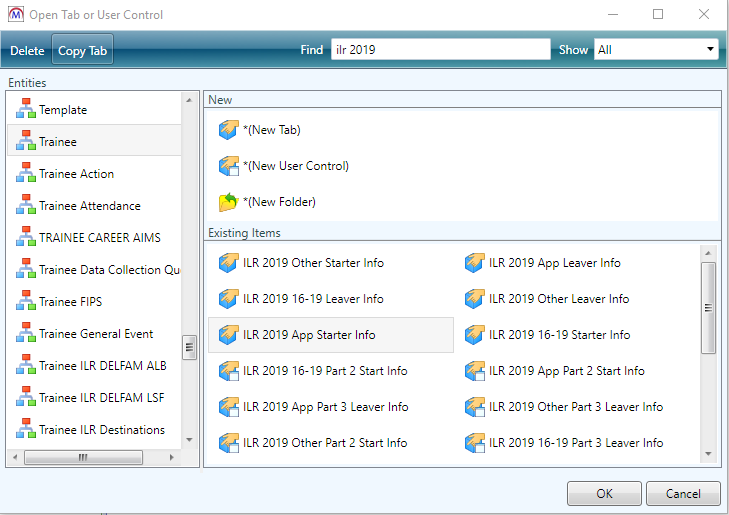
-
The screen designer will open a new tab based on the copied version, with the name appended with (1). Note that the new tab is unsaved and unpublished when initially created.
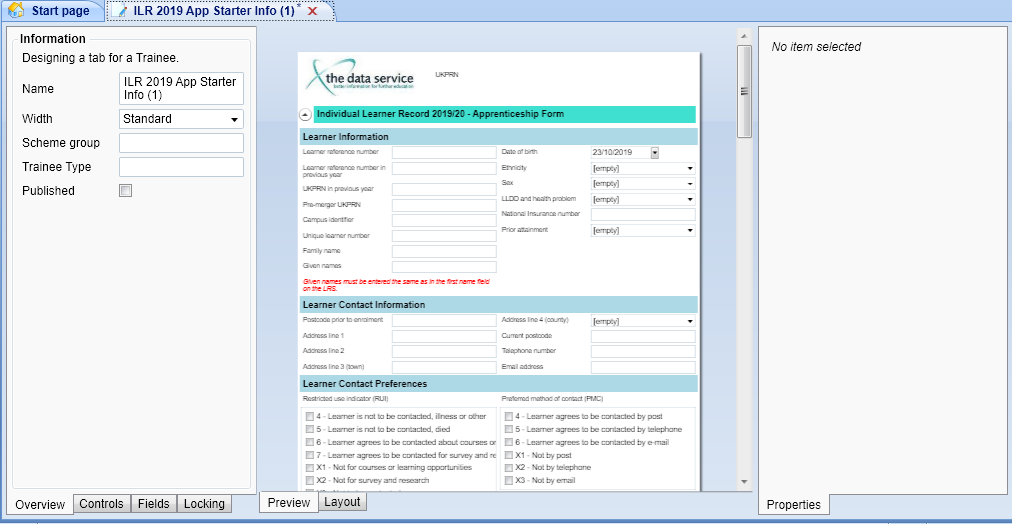
It is important to note that screen designer controls cannot be copied at present - only tabs can be copied. This means that if a tab with user controls is copied, ONLY the tab will be copied, and the controls on the new tab will be the original controls - i.e. changing the controls would affect both the old tab and the new tab.
Apprenticeship Service (AS) Export Updates
The AS export has been improved to make it simpler and faster to use. The main difference in how the process works is that the cohort reference on the ILR employment status has been removed. Instead, the learners exported under a particular cohort reference are stored in the table AS_EXPORTED_APPS.
The process for performing the export is now as follows:
-
Go to Management on the toolbar and click Export App Starts on the AS Directory panel of the ribbon.

- Select an employer or enter an EDRS ID to search for.
- Enter the UKPRN to search for.
- Enter the cohort reference to search for or apply to learners in the results.
- Select the date range for the search, which will include apprenticeships which started between the dates (inclusive).
-
Click Get Apprenticeships to perform the search.
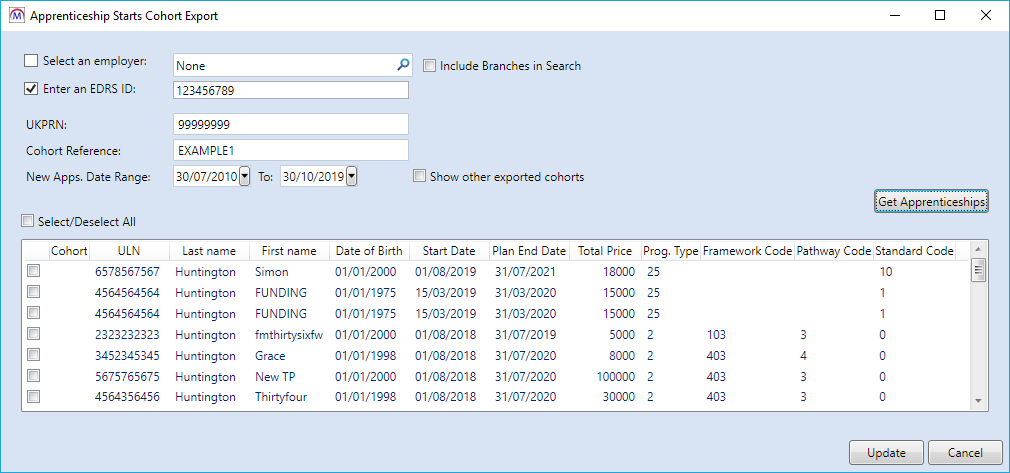
-
The results will show all unexported FM36 starts within the date range where their UKPRN and employer's EDRS ID match the ones entered. It will also show learners with a matching UKPRN and EDRS ID that have already been exported under the entered cohort reference.
If you wish to include learners who have already been exported under a different cohort reference, tick the Show other exported cohorts box. This will allow you to move them to the entered cohort reference instead.
A cohort in this context is a defined group of learners with the same EDRS ID, UKPRN and apprenticeship. These learners can be grouped under a cohort reference.
Select the learners you wish to export under the entered cohort reference and click Update.
- You will be prompted to save the export file. Choose a location and click Save.
-
You will be asked if you wish to open the file location. Click Yes or No as required.
The DOB field exports in the correct format of YYYY-MM-DD. However, if you open the export file in Excel, the date will be reformatted, so if you make any changes to the file in Excel then it is important to ensure that the DOB column is formatted as YYYY-MM-DD before saving.
-
The entered cohort reference will be applied to the selected learners.
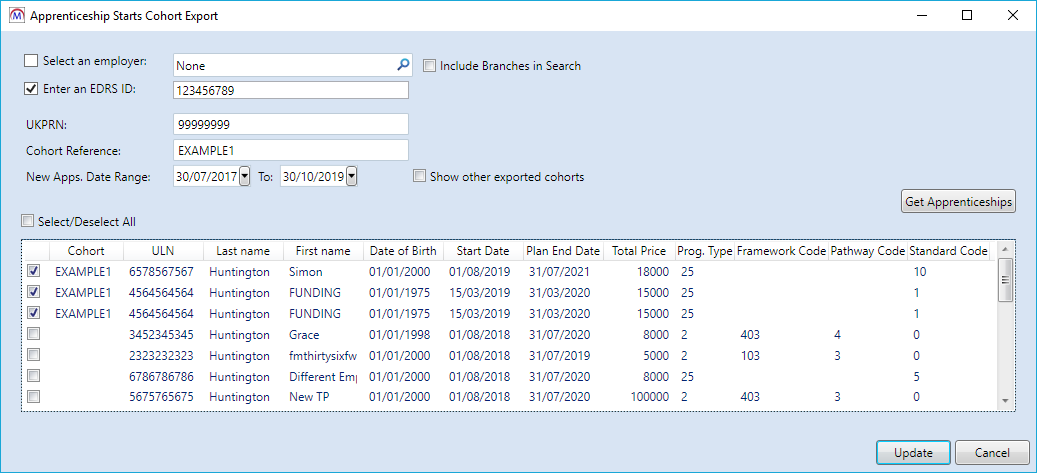
Bulk Upload
Exported AS export files can be imported back into Maytas. Existing cohort details in the AS_EXPORTED_APPS table will be updated so that they reflect the data in the import file.
To import a file:
- Go to Management on the toolbar and click Import on the AS Directory panel of the ribbon.
- Browse to and select the file to import and click Open.
-
The UKPRN, EDRS ID and cohort reference will be derived from the import file. You will be prompted to check and revise them if necessary. Click OK when ready.
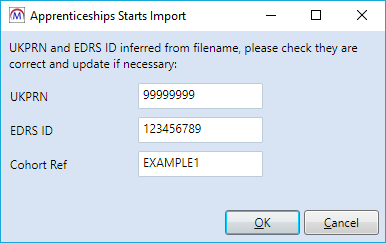
- The import will begin. Click OK on the confirmation message which appears.
- The progress of the import can be checked by going to Home on the toolbar and selecting Server Tasks | View Jobs.
Data Collection Queue
e-track allows you to send multiple data collection forms to an employer or learner for completion. This is done on the Data Queue tab on the relevant user's record, where a row can be added to the grid and configured for each form that needs to be completed.
As well as sending learner forms to a learner and employer forms to an employer, it is also possible to send an employer a learner form to complete on a learner's behalf. This is done by adding a row to the grid on the employer's Data Queue tab and then specifying which learner and form to use.
Requirements
On-line applications, data collection and data authentication require licences for e-track screen design and online applications, as well as licences for learners and employers. Please contact your account manager for the required licences, and consultancy will be required.
Import Data Queue Tabs
- In Maytas, go to Tools on the toolbar and click Import on the Screens panel of the ribbon.
- Click Browse.
- Browse to the e-track\Tabs folder of the upgrade, select the Data Queue tabs.m5rep package and click Open.
- Click Next, then click Finish.
- Go to Home on the toolbar and click Sync.
Form Setup
First, data collection forms should be created for learners, employers and visits as required (in the Trainee, Employer and Visit entities of the Maytas screen designer). The important points for a screen to work as a data collection form are on the screen designer Overview tab:
- Published - This should be ticked.
- e-track Publish - Application Form should be ticked.
- App Form ID - This should be a single-digit integer (i.e. 0 to 9) which is used to identify the form. Each learner form should have a different number, as should each employer form, but learner and employer forms can share a number. e.g. You could have a learner and an employer form both with an ID of 1, but not two learner forms with an ID of 1.
- Position - This essentially the page number of a form. For example, if you wanted a four page form, you would create a separate screen for each page, give them all the same App Form ID and then enter 1 to 4 for the position (i.e. 1 for page 1, 2 for page 2, etc).
Once you have created a form, a lookup should be added for it so that it is available in the Data Queue grid:
- In Maytas, go to Tools | DB Schema.
- Expand Tables on the left to show a list of tables in the database.
- For a learner form, expand TRAINEE_DATACOLLECTIONQUEUE, and for an employer form (or a learner form being completed by an employer on their behalf), expand EMPLOYER_DATACOLLECTIONQUEUE.
- Select FORMID.
-
If the Set button appears on the right, click it.
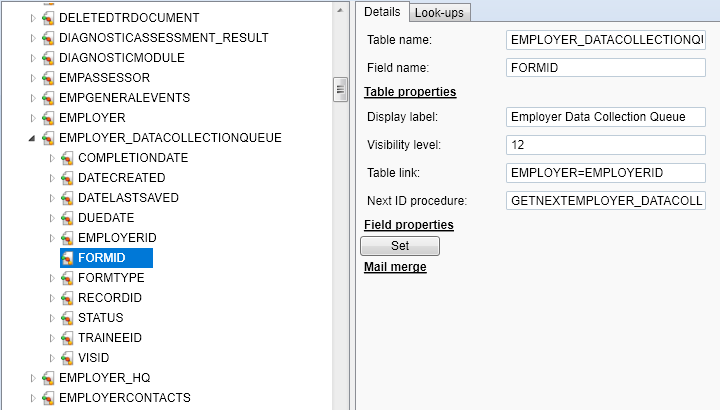
- Select the Look-ups tab.
- Click the
 button to add a new lookup.
button to add a new lookup. - The Short string should be two-characters:
- The first character is A for a learner form, P for an employer form or X for a visit form. Note that for a learner form being completed by an employer on the learner's behalf, this should be A.
The second character is the App Form ID of the form.
e.g. For a learner form with an ID of 3, the short string would be A3.
- The Long string should be the name or title of the form which will be displayed on the Data Queue grid.
- Click Apply and add additional lookups for forms as required.
- Go to Home on the toolbar and click Sync, then restart Maytas.
Learner Data Queue
To add a form to a learner's queue:
-
In Maytas, open the learner's record and go to the Data Queue tab.
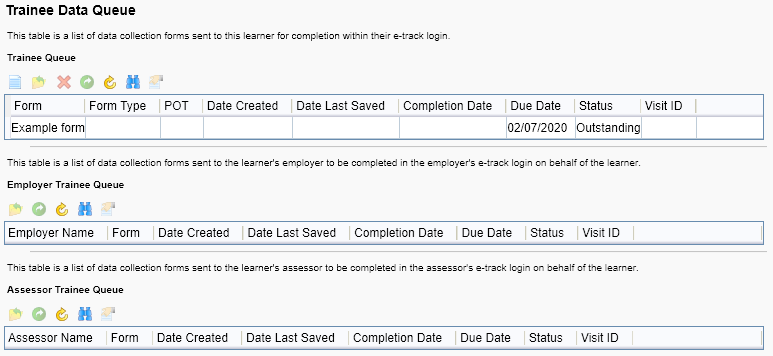
- You will see two grids. The top grid is for adding forms for a learner to complete. The bottom grid displays forms which have been sent to an employer to complete on behalf of the learner (this is covered below).
- Click the
 button on the top grid to add a new row.
button on the top grid to add a new row. - In the pop-up window which appears, select a Form (this is populated by the lookups set above) and enter a Due Date.
- Click OK.
- Click Apply.
The row will be added to the grid. The Date Created field will be populated with the current date (the learner record may need to be closed and re-opened for this to show) and the Status will be set to Outstanding, which means the learner has not yet started the form.
The next time the learner logs into e-track, they will be given a prompt to choose which form to complete (they will be given the option of all outstanding or in-progress forms currently in their queue).
When a learner clicks Save on a form, the status in the queue for that form will change to In Progress. If a learner closes their browser and then returns to the form later on, they will be able to continue from where they left off.
When a learner clicks Submit, providing any and all form validation has been met, the form status will change to Completed and they will not be prompted to complete the form again.
Employer Data Queue
To add an employer form to an employer's queue:
-
In Maytas, open the employer's record and go to the Data Queue tab.

- Click the
 button on the grid to add a new row.
button on the grid to add a new row. - In the pop-up window which appears, select a Form (this is populated by the lookups set above) and enter a Due Date.
- Click OK.
- Click Apply.
The row will be added to the grid. The Date Created field will be populated with the current date (the employer record may need to be closed and re-opened for this to show) and the Status will be set to Outstanding, which means the employer has not yet started the form.
The next time the employer logs into e-track, they will be given a prompt to choose which form to complete (they will be given the option of all outstanding or in-progress forms currently in their queue).
When an employer clicks Save on a form, the status in the queue for that form will change to In Progress. If an employer closes their browser and then returns to the form later on, they will be able to continue from where they left off.
When an employer clicks Submit, providing any and all form validation has been met, the form status will change to Completed and they will not be prompted to complete the form again.
Forms Completed by an Employer on behalf of a Learner
An employer can be sent a form to complete on behalf of a learner. To do this:
-
In Maytas, open the employer's record and go to the Data Queue tab.

- Click the
 button on the grid to add a new row.
button on the grid to add a new row. -
In the pop-up window which appears, complete the following fields:
- Trainee ID - Use the
 button to search for an select the learner for whom the employer will be completing the form.
button to search for an select the learner for whom the employer will be completing the form. - Form - Select the form to complete (this is populated by the lookups set above).
- Form Type - Select Employer on behalf of trainee.
- Due Date - Enter the date by which the form should be completed.
- Trainee ID - Use the
- Click OK.
- Click Apply.
The row will be added to the grid. The Date Created field will be populated with the current date (the employer record may need to be closed and re-opened for this to show) and the Status will be set to Outstanding, which means the employer has not yet started the form.
A row will also be added to the bottom grid on the learner's Data Queue tab to indicate their employer has an outstanding form to complete on their behalf.
The next time the employer logs into e-track, they will be given a prompt to choose which form to complete (they will be given the option of all outstanding or in-progress forms currently in their queue).
When an employer clicks Save on a form, the status in the queue for that form will change to In Progress. If an employer closes their browser and then returns to the form later on, they will be able to continue from where they left off.
When an employer clicks Submit, providing any and all form validation has been met, the form status will change to Completed and they will not be prompted to complete the form again.
Data Collection Queue Report
A report is available to show the current queues for learners and employers. To import the report:
- In Maytas, go to Home on the toolbar and click Import on the Reports panel of the ribbon.
- Click Add Files.
- Browse to the Maytas 5\Extras\Module Reports folder of the upgrade.
- Select Data Collection Queue.m5rep and click Open.
- Click Finish.
- Once the report has finished importing, click Finish.
The report is called Data Collection Queue and can be found in the Audit folder of the reports library.
ACT Tool Update - Achievement Dates
The Apprenticeship Contract Type (ACT) tool has been updated so that programme aim ACT records on apprenticeship standards now use the achievement date (rather than the actual end date) for the Date Applies field. This is as per guidance in the 2019/20 provider support manual.
The tool can be found on a learner record by going to ILR Tools | Set Apprenticeship (FM36) Contract Types.
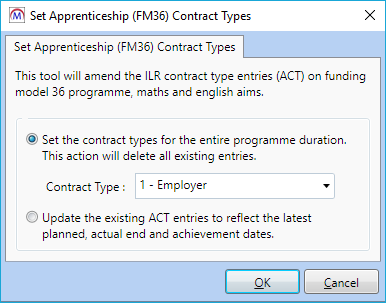
Report Generator - Permissions for Custom Filters and Expressions
Custom filters and custom expression functions in Report Generator now require user permissions to be available. To give a user permission for these features:
- Go to Tools | Edit Permissions.
- Select the user or group which requires permission.
- Go to the Commands tab and expand the Reports section.
- Set the Edit Custom Filter and expressions permission to Visible.
- Click Apply.
- Go to Home on the toolbar and click the Sync button.
- Restart Maytas for the permissions to take effect.
Destination Tracking - Update to Follow-ups
The Destination Tracking module has been updated so that all learners who are subject to destination tracking will be sent surveys:
- Immediately after ending learning (based on the actual end date)
- 6 months after ending learning
- 12 months after ending learning
Previously, the timeframe in which learners were sent surveys depended on the funding model.
Employability Fund 2019 Tab (Scottish contracts)
The Employability Fund 2019 tab for Scottish contracts is now available. To import the tab:
- Go to Tools on the toolbar.
- Click Import on the Screens panel of the ribbon.
- Click Browse.
- Browse to the Maytas 5\Extras\Tabs folder of the upgrade, select Employability Fund 2019.m5tab and click Open.
- Click Next, then click Finish.
- Sync Maytas to apply the tab to all clients.
The Employability Fund 2019 tab will now be available in learner records.
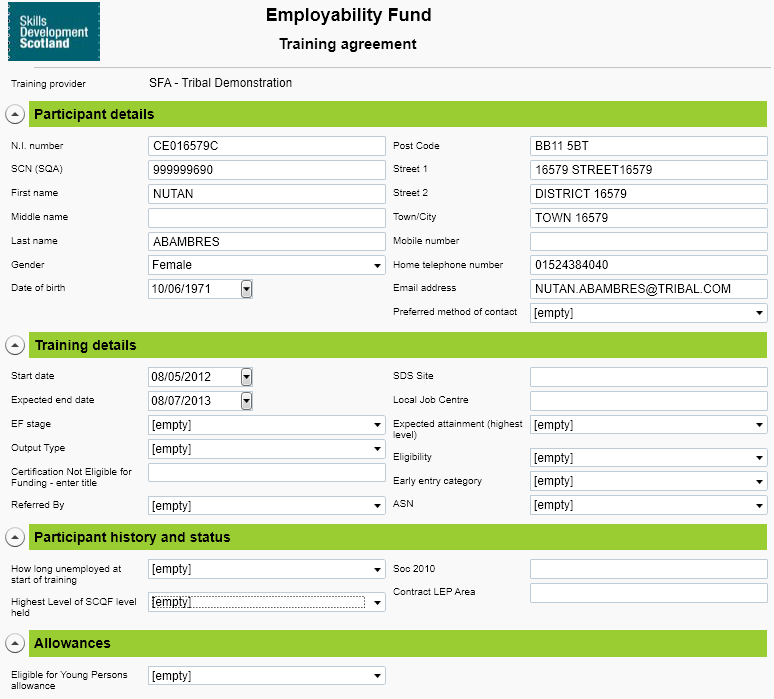
Reports Library 1.0.3.3 Updates
QAR 2018/19 Rulesets
The Achievement Rate reports have been updated to include the 2018/19 rules for apprenticeships and education & training.
The most substantial rule change for both rulesets is that transfers to a new provider due to a merger are now excluded. However, the criteria for this exclusion rule is not reproducible in full, as it requires both the actual end date from the old provider and the start date at the new provider, and only one of these may be present in the database. The rule states:
[Exclude] aims where Withdrawal Reason is 47 (Learner has transferred to another provider due to merger), and the Learning Actual End Date is less than the Learning Start Date on the new UKPRN (matching on Unique Learning Number).
The Learning Start Date on the new UKPRN must be within 30 days or less than the Learning Actual End Date on the original UKPRN.
This has been implemented in Maytas so that learners with a withdrawal reason of 47 are excluded under this rule regardless of the dates, since the time between the dates cannot be reliably determined.
QAR Reconciler Updates for 2018/19
The QAR Reconciler has been updated to allow 2018/19 apprenticeship QAR files to be reconciled with Maytas data. The report functions in the same way as it previously did, with the addition of a column on the first drilldown level which suggests the possible causes of discrepancies for each row. You can then drilldown to individual learners to analyse the data in detail.
The QAR Reconciler is included as part of Reports Library version 1.0.3.3.
To import an apprenticeship QAR file for 2018/19:
- Go to Management on the toolbar and select Upload QAR | Upload QAR Apps file. Note that both 2017/18 and 2018/19 QAR files can be uploaded via this option.
- Browse to and select the QAR file and click Open.
- The file will now be uploaded. You can view the progress of the upload by going to Home on the toolbar and selecting Server Tasks | View Jobs.
The QAR Reconciler can be found in the Quality folder of the reports library.
Financial Plan Overview Update for 2019/20
The Financial Plan Overview report has been updated so that it supports plans for 2019/20. The functionality of the report is otherwise the same as before.
Ofsted Inspection Report 2019
An updated Ofsted Inspection report for 2019 is available. This is largely the same as the previous version, with the following changes:
New Tables
- Details of the courses/programmes being delivered and their mode of delivery - This shows the number of live aims (including programme aims) by funding model, programme type, aim type (programme, main or other) and aim type.
- Current learners by age group - This shows the number of live POTs by age group at start (14-16, 16-18 and 19+). Note that learners who are 16 on their start date fall into the 16-18 category.
Altered Tables
- Apprenticeship learners by sector, level, age group and standard/framework - This has been separated into a table for standards and a table for frameworks, whereas before they were combined.
- Geographical spread of training premises and learners by sector - This is now grouped by country first rather than employer, to place more emphasis on the geographical aspect of the data.
Assessor Caseload Summary Update
The Assessor Caseload Summary report has been updated to include the main aim planned end date on the drilldown.